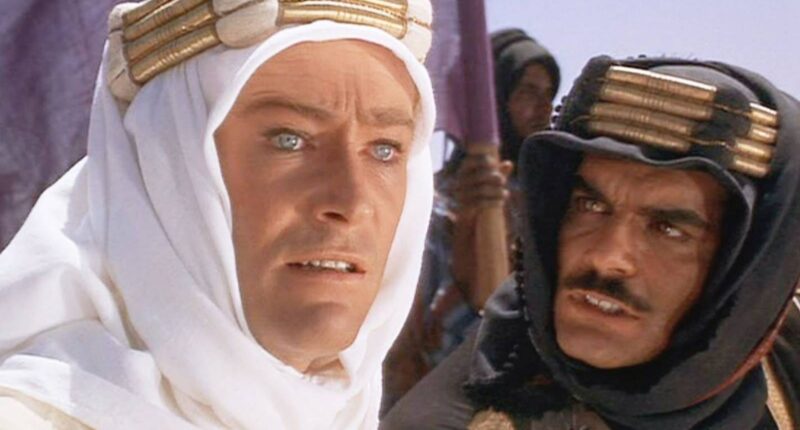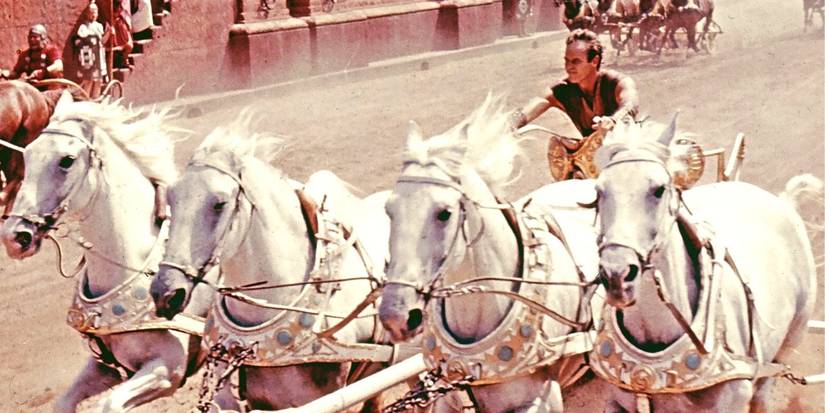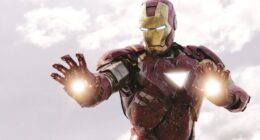Movies don’t get bigger than epics, and many of the greatest epics made over the last 100 years rank among the best films ever made. They offer bold storytelling made on a tremendous scale that never loses sight of the characters that populate their wide-open worlds. Any epic movie that isn’t a complete disaster is worth celebrating for how ambitious an undertaking they are, but the best of them represent something truly special.
Whether historical, fantastical, or somewhere in between, the best epics that have been projected onto screens since 1925 all offer the same sense of overwhelming awe that can only be achieved on the grandest scale. Thrilling, moving, and inspiring, epics offer the unique kind of magic that only movies can provide. In the past 100 years, there haven’t been any better epics than these ten, which will be ranked based on their impact, overall quality, and legacy in the epic genre as a whole.
10
‘Ben-Hur’ (1959)
A classic Hollywood biblical epic, the fictional story of Ben-Hur has been told on screen a number of times, with the first adaptation of Lew Wallace‘s novel hitting screens in 1907 and the most recent in 2016. The definitive filmic version of this large-scale story, set during the time of Christ and the Roman Empire, was made in 1959 by legendary director William Wyler and starring Charlton Heston.
As Judah Ben-Hur, a Jewish prince turned slave and charioteer, Heston is as square-jawed as heroes came back then, and the movie itself is glossy entertainment as only Hollywood does. The famous chariot race, which took nearly a year to plan, is still one of the most perfectly composed action sequences ever put on film, and it alone guaranteed Ben-Hur‘s place among the greatest epics ever made. Despite multiple attempts to remake the story for modern audiences on film and television, none have come close to this film’s grandeur.
9
‘Star Wars: Episode V – The Empire Strikes Back’ (1980)
From Ancient Rome to a galaxy far, far away, the Star Wars franchise has pulled many inspirations from epics such as Ben-Hur and many like it. George Lucas‘ original space opera took its dozens of influences and supercharged them into a wonderfully realized fantasy world, and the sequel is even better. Commonly cited as the perfect example of a sequel that’s better than its predecessor, The Empire Strikes Back is a grand expansion of its setting and character, offering a more mature space adventure that is still considered the high point of the entire franchise.
Picking up with Luke Skywalker and the rest of the Rebel Alliance after the destruction of the Death Star, the movie puts its characters back on their heels as they have to split up and flee across the galaxy to evade the evil Empire. While Han Solo and Leia’s romance begins to blossom, Luke is stuck in a swamp learning the ways of the Force from one of the most iconic puppets of all time. It may not end on a triumphant note as the first film did, but The Empire Strikes Back is still an enduring masterpiece with one hell of a cliffhanger.
8
‘Mad Max: Fury Road’ (2015)
Proving that Hollywood, or at least one crazy Aussie director, can still make compelling epics in the modern movie landscape, Mad Max: Fury Road takes the best parts of its three precursors and puts them under the hood of one big, bad monster truck of an epic action movie. Tom Hardy is the gruff new Max, taking over from Mel Gibson, and Charlize Theron is every bit his equal as Furiosa, while Hugh Keays-Byrne, in his second time playing a villain in the franchise, is the epicly disgusting Immortan Joe.
Structured as one prolonged chase across the desert, the movie is a masterpiece of visual storytelling, with some of the greatest action ever put on screen. With a beautiful blend of stunt work and visual effects artistry, all lensed by the amazing John Seale, the apocalypse has never looked so good, and it sounds even better. All that technical wizardry is in service of a stripped-down plot that leaves plenty of room for colorful character work and an undercurrent of feminism that is the true engine underneath the muscular motor car.
7
‘Apocalypse Now’ (1979)
War has served as the backdrop for all sorts of epics, with the Vietnam War in particular being a source of major inspiration for filmmakers in the ’70s and ’80s. Of all the films to tackle that messy subject matter, none is bigger or better than Francis Ford Coppola‘s Apocalypse Now. Transplanting Joseph Campbell‘s Heart of Darkness into a contemporary wartime setting, the film was as epic and lengthy a production as the story it portrays, with Coppola and company spending over a year shooting in the Philippines.
Set in 1969, the film follows Martin Sheen‘s disillusioned Captain Willard, who is tasked with terminating with extreme prejudice the mad Colonel Kurtz, played by Marlon Brando. Re-teaming with Coppola after his Oscar-winning performance in The Godfather, Brando famously turned up on set having gained a considerable amount of weight, causing Coppola to strategically film around him using heavy shadows and close-ups. The result gives the final confrontational act of the film a surreal quality, memorably ending one of the greatest war epics ever made.
6
‘The Good, the Bad and the Ugly’ (1966)
Few segments of American history are as expensive and wide open as the old West, offering a sweeping setting for hundreds of grand movies. Ironically, some of the very best of the genre weren’t filmed on the wide open plains of the American West, but in the European countryside as part of the spaghetti Western movement. Of these Italian-produced classics that also qualify as true epics, it’s hard to top Sergio Leone‘s masterpiece The Good, the Bad and the Ugly. As the final part in his Dollars trilogy, Leone pulled out all the stops for a Civil War-set tale of greed and buried treasure.
Clint Eastwood returns as his iconic Man with No Name character, here given the moniker of Blondie, who finds himself competing for a load of Confederate gold buried in a cemetery. He’s given stiff competition in the form of Lee Van Cleef‘s ice-cold assassin and Eli Wallach‘s bumbling bandit. Coupled with Leone’s penchant for widescreen cinematography, which he fills with both gorgeous landscapes and the faces of his actors, and Ennio Morricone‘s iconic score, The Good, the Bad and the Ugly is an epic Western of immeasurable entertainment value accomplished with an admirable amount of skill.
5
‘Schindler’s List’ (1993)
Sometimes, the size of a film isn’t just meant for gigantic set pieces or explosive action. It can also help capture the immense weight of an incredible tragedy. There are few historical events of the 20th century as tragic as the Holocaust, and there are few films that encapsulate how large-scale its horrors truly were as Steven Spielberg‘s Schindler’s List does. A film that was years in development, the director had misgivings about dramatizing such an important subject, but eventually relented after realizing the impact it could have, particularly in the face of the rising tide of Holocaust deniers.
Based on the real-life Oskar Schindler, an industrialist and member of the Nazi party, who goes from capitalist to humanitarian after witnessing the atrocities carried out against the Polish Jews of Kraków. He employs them in his factories to spare them from the horrors of the concentration camps and eventually sacrifices his entire fortune. It’s a true, inspiring story inexorably tied to the horrors that surround it, which Spielberg dramatizes in unflinching fashion. Schindler’s List is epic filmmaking with a purpose, and it deserves its plaudits for shining a giant light on one of the darkest chapters in history.
4
‘Come and See’ (1985)
Just as impactful and even more visceral as Spielberg’s war epic is the Soviet-produced Come and See, which depicts further Nazi atrocities through the occupation of Soviet Belarus. Simultaneously grim and gritty, and hauntingly surreal, the movie is an anti-war masterpiece that has only grown in stature since its original release. It may be one of the hardest to watch epics ever made, but it is just as urgently important.
Focusing its narrative through the perspective of a young Belarusian teen who witnesses firsthand horrific violence at the hands of the Nazi occupiers, Come and See is a brutal and punishing viewing experience, hardly ever relenting from its true horrors. Lead actor Aleksei Kravchenko delivers one of the most astounding child performances ever put on screen. He, and the film as a whole, linger in the mind long after the violence has ceased.
3
‘2001: A Space Odyssey’ (1968)
Stanley Kubrick was a singular cinematic voice, and his epic films, from Spartacus to Barry Lyndon, all immersed audiences in their worlds with stunning effect, but none more so than his sci-fi odyssey across space and time. 2001: A Space Odyssey is a landmark science fiction film, made with unparalleled visual effects, a full year before humanity had ever even landed on the moon. Groundbreaking and ahead of its time, it’s a timeless science fiction epic.
Following a voyage to Jupiter to investigate a mysterious alien monolith, a crew of astronauts face their greatest threat in the form of the prescient A.I. villain Hal 9000. Deliberately paced and plotted, the film is as epic in scale as it is thoughtful in its approach. Kubrick reportedly wanted to make a film about man’s relationship to the universe, and he starkly communicates in the wide-ranging shots that explore the infinite blackness of space and especially in the surreal ending that transcends traditional visuals for an emotional and experimental climax.
2
‘Seven Samurai’ (1954)
Akira Kurosawa‘s legendary directorial career has influenced generations of filmmakers and their respective films. His later epics like Kagemusha and Ran are incredible visual feats that would be considered the peaks in many other filmographies, but they simply can’t compare to his magnum opus epic Seven Samurai. As influential an action film as there has ever been, it essentially invented the ragtag team trope and all its accompanying elements.
Set in 16th-century Japan, the plot involves a mountain village beset by bandits, leading the villagers to seek the help of an aging ronin, who assembles the titular seven samurai to help defend them. The similarities between the film and Westerns were noted upon its release, and, in turn, it inspired dozens of Westerns, most directly in the seminal The Magnificent Seven. For all the sons of Kurosawa’s masterpiece, none of them approach its perfect blend of epic adventure, honor-driven characters, and expertly choreographed action.
1
‘Lawrence of Arabia’ (1962)
A director who is as synonymous with cinematic epics as there ever has been, David Lean‘s efforts are among the greatest ever made. Doctor Zhivago and The Bridge on the River Kwai both deserve recognition, but there are few, if any, epics like Lawrence of Arabia. Inspirational to every filmmaker on this list, Lean’s epic, if highly fictionalized, dramatization of the life and exploits of T.E. Lawrence is one of the greatest films ever made, full stop.
Peter O’Toole‘s performance as Lawrence is the template for movie star presence, combining an intensely magnetic persona layered over an emotional vulnerability. The film immortalized O’Toole for his complex portrayal of a complex man, and his striking physical appearance stands out in the stark desert settings as Lawrence finds himself aligned with Arab forces against the Turks. Shot in glorious widescreen, there’s hardly a single frame of the film that wouldn’t be suitable to be framed as a work of art, with so many of its singular shots among the most iconic ever filmed. Lawrence of Arabia is what epic filmmaking looks like in the hands of a master filmmaker working with a superlative star.




.jpg?q=49&fit=crop&w=825&dpr=2)






.jpg?q=49&fit=crop&w=825&dpr=2)







